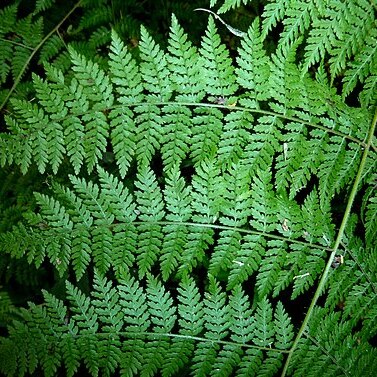Plants terrestrial. Rhizome wide-creeping, subterranean or epigeal, terete, to 8 mm in diameter, initially densely set with dark brown to ferrugineous, pluricellular, uniseriate acicular hairs, to 1.5 mm long. Fronds to 110 mm apart, arching, straggling in large plants, to 3 m long; stipe firm, proximally castaneus to ferrugineous, stramineous higher up, adaxially shallowly sulcate, to 1.2 m long, to 15 mm in diameter, initially closely set with soft pluricellular, uniseriate acicular hairs, often becoming subglabrous or glabrous later; lamina anadromous to catadromous, ovate-deltate, to 4-pinnate-pinnatifid, to 2.5 m long, to 2 m wide with up to 15 petiolated pinna pairs; rachis stramineous, adaxially shallowly sulcate, sulcus confluent with that of the lower order axes, initially closely set with fine pluricellular, uniseriate acicular hairs, often glabrous later; pinnae petiolate, petiole to 65 mm long, ovate to lanceolate, opposite to alternate, basally widely spaced, imbricate or not, more closely spaced distally, often somewhat imbricate, to 4-pinnate-pinnatifid, basal pinnae not, or conspicuously basiscopically developed, to 1 m long, to 500 mm wide, with up to 17 petiolated pinnule pairs; pinna-rachis adaxially sulcate, to 6 mm in diameter, set with hairs similar to those on the rachis, lower order axes also with oblong pluricellular, uniseriate hairs; pinnules anadromous or catadromous, petiolate, petiole to 30 mm long, ovate to lanceolate, opposite to alternate, closely to widely spaced, to 3-pinnate-pinnatifid, to 430 mm long, to 330 mm wide, with up to 14 segment pairs; segments petiolate, petiole to 10 mm long, lanceolate to oblong-acuminate, alternate, closely to widely spaced, to 2-pinnate-pinnatifid, to 160 mm long, to 70 mm wide; ultimate segments petiolate, petiole to 2 mm long, membranous to thinly herbaceous, ovate to oblong-acuminate, opposite to alternate, closely to widely spaced, lobed to pinnatifid, to 35 mm long, to 13 mm wide, adaxially and abaxially set with acicular pluricellular, uniseriate hairs along the costules and veins; lobes oblong-obtuse, to 8 mm long, to 4 mm wide, obtusely dentate. Venation anadromous or catadromous, evident, free, the branches simple or forked, ending in the teeth near the margin. Aerophores in a narrow, continuous dorsilateral line along the axes. Sori near-marginal, proximal on the lobes, at or near the ending of a simple, or anadromous branch of a forked vein, singly or up to 2 pairs per lobe, to 1.2 mm in diameter when mature; indusium a strongly modified lobe tooth, erose to fimbriate; receptacle nude; sporangium long-stalked, simple, 3-seriate below the capsule, capsule with (12-)13(-19) indurated annulus cells. Spores 64 per sporangium, yellow, ellipsoidal, monolete, echinulate, (24-)29.14(-38) x (15-)19.63(-26) µm.
More
Rhizome widely creeping, terete, up to 8 mm in diam.; initially densely set with brown to ferruginous, acicular hairs, up to 1.5 mm long. Fronds up to 110 mm apart, arching, straggling in large plants, up to 3 m long. Stipe firm, proximally castaneous to ferruginous, up to 1.2 m long, up to 15 mm in diam.; with soft acicular hairs, often becoming subglabrous or glabrous later. Lamina ovate-deltate, up to 4-pinnate-pinnatifid, up to 2.5 x 2 m, with up to 15 petiolated pinna pairs. Pinnae ovate to lanceolate, up to 4-pinnate-pinnatifid, basal pinnae conspicuously or not basiscopically developed, up to 1 x 0.5 m; petioles up to 65 mm long; with up to 17 petiolated pinnule pairs. Sori near-marginal, proximal on lobes, 1 or 2 pairs per lobe, up to 1.2 mm in diam. when mature. Indusium a strongly modified lobe tooth, erose to fimbriate.
Rhizomatous perennial forming large stands. Fronds to 3 m long, stipe near glabrous at maturity, lamina 3-to 5-pinnatifid, ultimate segments oblong, crenate to pinnatifid. Sori singly on acroscopic margin of lobes of ultimate segments, pseudo-indusium subentire.
Rhizome creeping, set with brown or reddish hairs. Veins mostly free. Fronds 2-to 5-pinnatifid. Pinnae up to 1 m long. Pseudo-indusium present. Sori small, subcircular, opening inwards, borne singly on acroscopic margin of ultimate segments.

